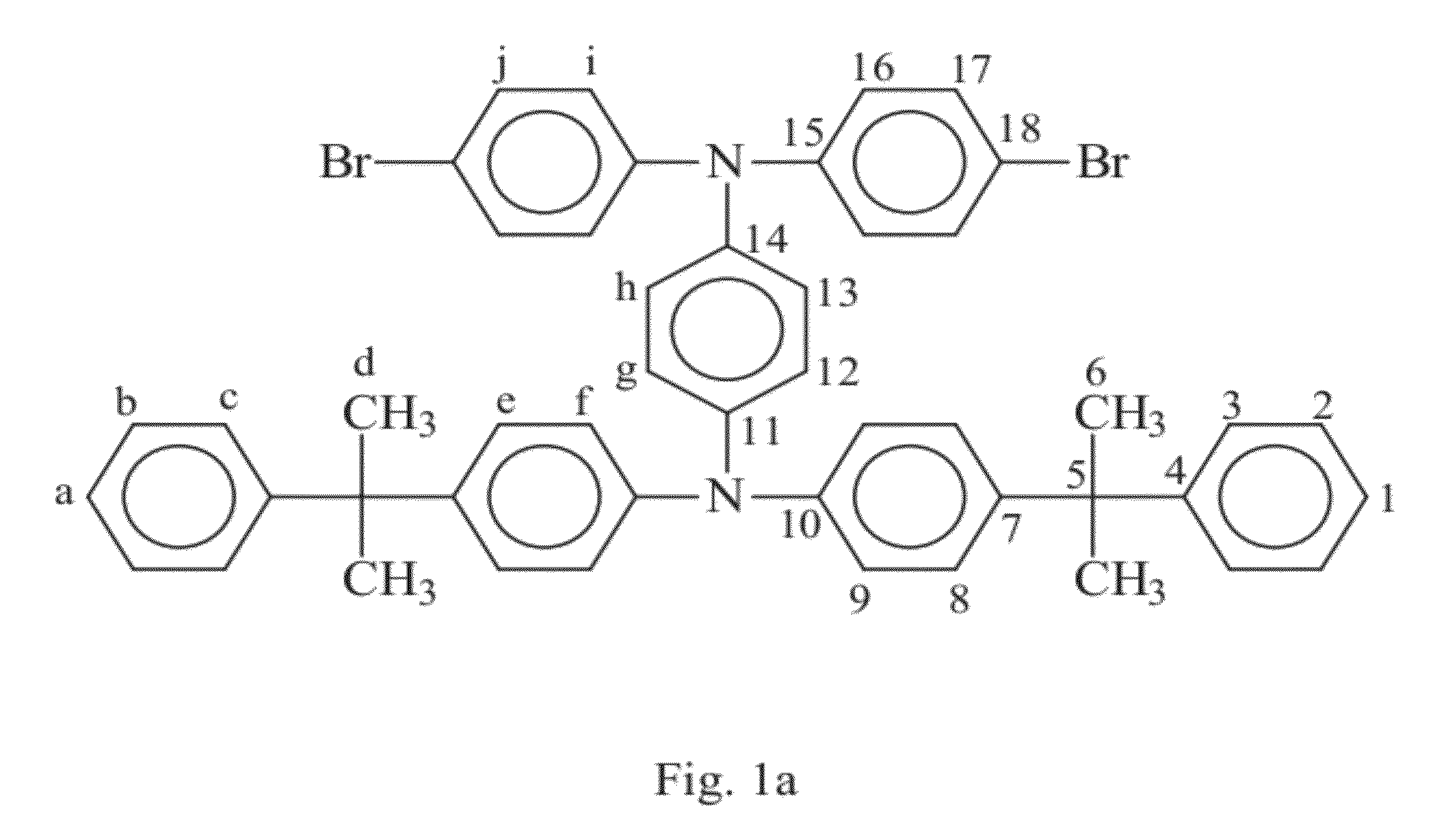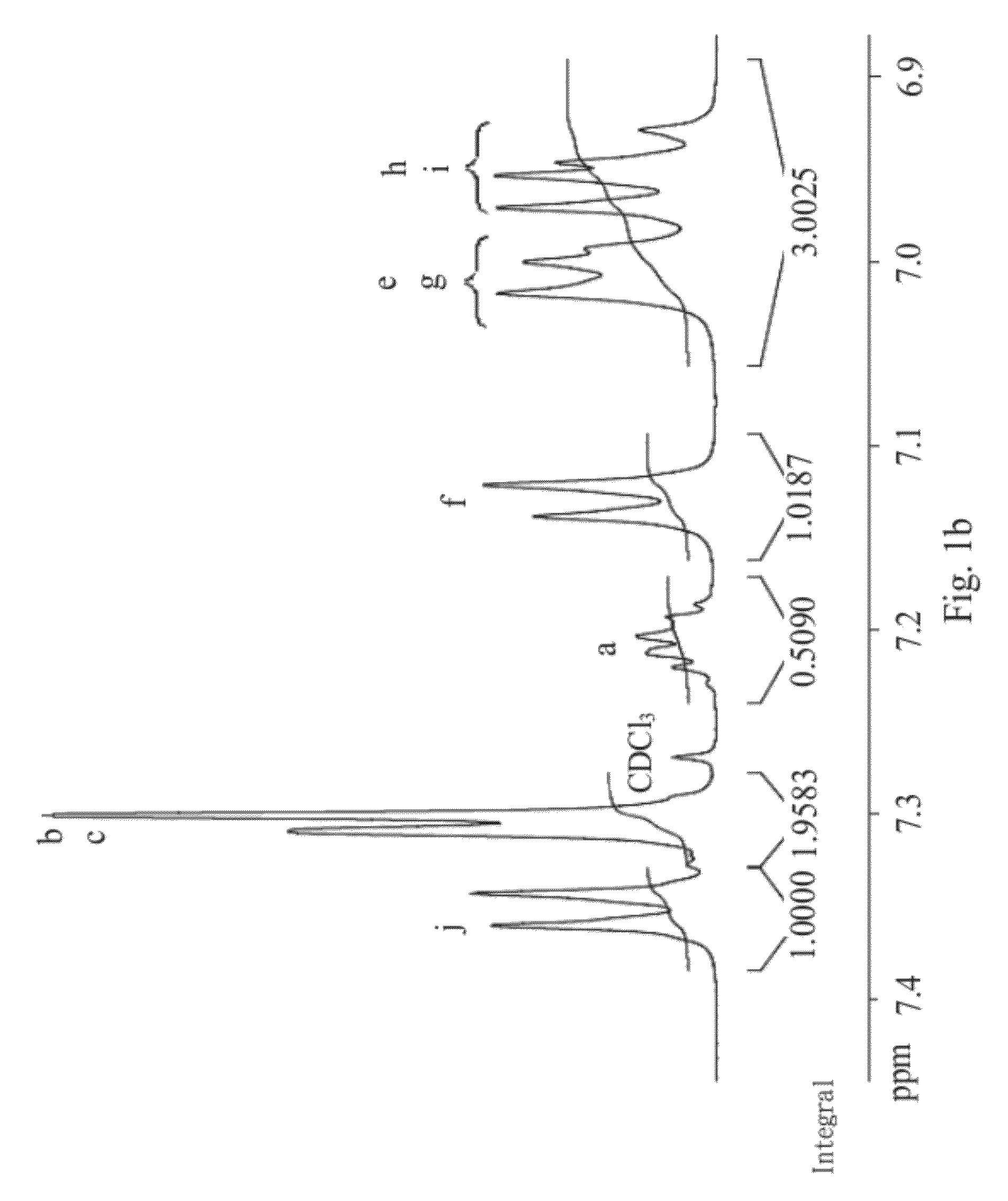Polymer and copolymer and method of making the same
a copolymer and polymer technology, applied in the field of polymers, can solve the problems of short life and poor stability of the above-mentioned polymer organic electroluminescent devices, and achieve the effects of good solubility, high carrier mobility, and good heat toleran
- Summary
- Abstract
- Description
- Claims
- Application Information
AI Technical Summary
Benefits of technology
Problems solved by technology
Method used
Image
Examples
example 1
Synthesis of poly-bis[4-(2-phenyl-2-propyl)phenyl]dioctylfluorene (PBTPAFL)
[0079]As shown in FIG. 10, in step 101, the dibromobenzene compound (BBTPA) (0.92 mmol), fluoreneboronic acid compound (9,9-dioctylfluorene-2,7-diboronic acid bis(1,3-propanediol) ester) (0.92 mmol), 3M potassium carbonate solution (K2CO3(aq)) (0.918 mL) and toluene (20 mL) are placed into a reaction vessel filled with nitrogen. Then, in step 102, tetrakis(triphenylphosphine)palladium (Pd(PPh3)4) (0.6 mmol) is added and the solution mixture is heated to temperature of 100˜110° C. (preferably to 105° C.) and is refluxed for 48 hours. Subsequently, in step 103, the polymer solution is deposited in 1 liter of methanol solution. The product is washed with a great amount of water after the solution is filtered. Then, the product is dissolved in toluene again and is deposited in 1 liter of methanol solution and repeat three times. Subsequently, in step 104, the product is heated to temperature 145˜155° C. (preferab...
example 2
Synthesis of the copolymer of bis[4-(2-phenyl-2-propyl)phenyl]dioctylfluorene and 2,5-dibromothiophene
[0093]As shown in FIG. 11, in step 201, the dibromobenzene compound (BBTPA) (0.0895 mmol), fluoreneboronic acid compound (9,9-dioctylfluorene-2,7-diboronic acid bis(1,3-propanediol) ester) (0.8955 mmol), 2,5-dibromothiophene compound (0.806 mmol), 3M potassium carbonate solution (K2CO3(aq)) (2 mL) and toluene (4 mL) are placed into a reaction vessel filled with nitrogen. Then, in step 202, tetrakis(triphenylphosphine)palladium (Pd(PPh3)4) (3 mmol) is added and the solution mixture is heated to temperature of 100˜110° C. (preferably to 105° C.) and is refluxed for 48 hours. Subsequently, in step 203, the polymer solution is deposited in 1 liter of methanol solution. The product is washed with a great amount of water after the solution is filtered. Then, the product is dissolved in toluene again and is deposited in 1 liter of methanol solution and repeat three times. Subsequently, in ...
PUM
| Property | Measurement | Unit |
|---|---|---|
| glass transition temperature | aaaaa | aaaaa |
| temperature | aaaaa | aaaaa |
| temperature | aaaaa | aaaaa |
Abstract
Description
Claims
Application Information
 Login to View More
Login to View More - R&D
- Intellectual Property
- Life Sciences
- Materials
- Tech Scout
- Unparalleled Data Quality
- Higher Quality Content
- 60% Fewer Hallucinations
Browse by: Latest US Patents, China's latest patents, Technical Efficacy Thesaurus, Application Domain, Technology Topic, Popular Technical Reports.
© 2025 PatSnap. All rights reserved.Legal|Privacy policy|Modern Slavery Act Transparency Statement|Sitemap|About US| Contact US: help@patsnap.com



